Orthodox Patriarchate Istanbul & St. George Church
The Greek Orthodox Patriarchate Istanbul- Introduction
Alright, finally we are here in Fener (Phanar or Fanar) and Balat Region. As you know, there are many great locations in Istanbul, however, we can’t miss these district’s great monuments. The Greek Orthodox Patriarchate Istanbul is definitely one of them.
You know this is old Istanbul. We can say that these districts (Cibali, Fener and Balat) are the mix of religions. So, you can find synagogues, churches, and mosques standing together.
The church is dedicated to St. George. And, there are many interesting topics we want to cover in this post regarding the patriarchate and the church.
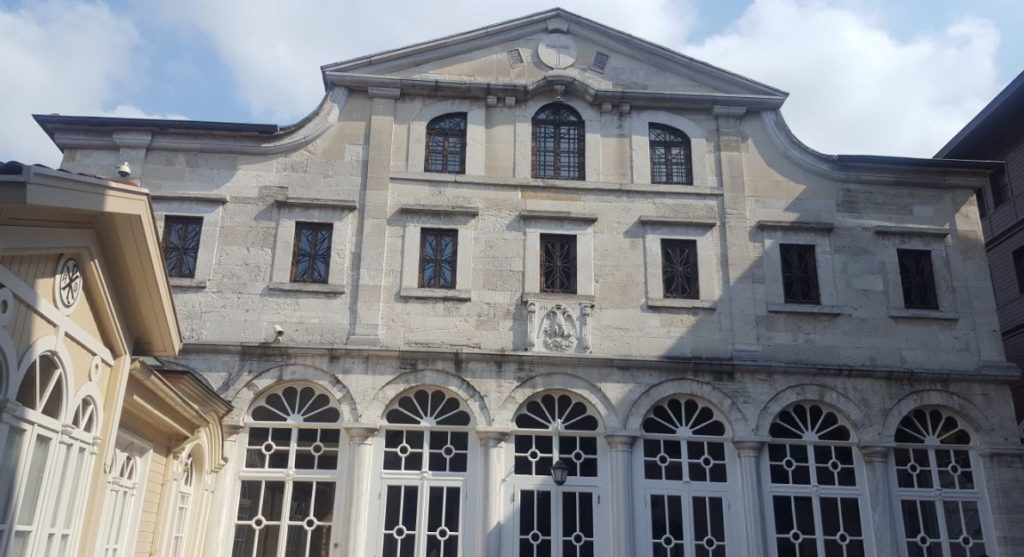
The Greek Orthodox Patriarchate Istanbul – Information
We all know how Istanbul is important for Christianity and especially for Orthodoxy. Moreover, Constantinople was the center of the Eastern Roman Empire for a long time. Even we can say that Anatolia was also a big player for Christianity.
People also know the Greek patriarchate as the Ecumenical Orthodox Patriarchate. So, ecumenical has different meanings. Firstly, it means something universal or something that has a wide, general application. Often the consideration is about Christianity which means bringing all Christian religions together. So, another explanation is “first among equals” which is used for this patriarchate. Due to being the most historical patriarchate, people mostly consider as the holiest. But literally and officially, the patriarchate can not impose sanctions on another one. Additionally, as a reminder, all autocephalous and autonomous churches are just parts of the Orthodox church.
Bartholomew, Archbishop of Constantinople-New Rome and Ecumenical Patriarch was elected in 1991 and still pursuing his role. He was born in Turkey, spent a lot of years abroad for his studies. You probably saw the news in this year granting autocephaly to the Church of Ukraine. [1]
The Greek Orthodox Patriarchate Istanbul – History
Early Period
You can find a short description of Istanbul in this post. So, Istanbul or Constantinople was always important for Christians and Muslims.
Greek colonists lived in this city as Byzantium till Romans. St. Andrew founded the bishopric of Byzantium, and then the first bishop was St. Andrew’s disciple Stachys (AD 38–54). [2]
After Byzantium was part of Romans, they considered Constantinople as New Rome and recognized the bishop of Constantinople as equal as the Rome’s bishop. After the death of Theodosius I, you know his sons divided the Empire into two pieces and Eastern Roman has been founded which we are also calling as the Byzantine. So, these moves definitely affected Christianity at those times. And, in the following centuries, the bishop has been named as ecumenical patriarch. [2]
The Great Schism
The tensions increased year by year between two empires and between those churches. There were many occasions. The Council of Chalcedon decisions at 451, Pope Leo’s declaration about Charlemagne – the Emperor of the Romans and more on. And then, boom, Great Schism at 1054. [3, 4, 5]
The Pope’s representative Cardinal Humbert entered the Hagia Sophia which was the main place for worship, left a document including the excommunication [6]. We can consider this as the final shot, but please also note that excommunication came from both parties.
The Latins in Fourth Crusade captured the Constantinople in 1204 and Byzantines moved the patriarchate to Nicaea. This period is mostly stated as a dark period for Istanbul. But Byzantines recaptured the city in 1261 and transferred the patriarchate back in Constantinople.
The Conquest by the Ottomans
At 1453, the Ottomans conquered the city, especially Fatih Sultan Mehmed- Ottoman Emperor recognized the patriarch as the ethnarch and he increased the authority of the patriarchate. [2]
Recent Period
The patriarchate changed its location many times, but St. George church the current location in Fener has been used since the 1600s.
Nationalism waves affected the patriarchate in the 1800s. And, some nations such as Bulgarians, Serbians and Romanians founded their self-governed churches. The reference here explains the autocephalous and autonomous churches. Check this one if you are more interested in. [7]
The church had hard times in the previous centuries. The fire demolished the current church in the 1940s. And, it was restored at the end of the 80s. The church and the patriarchate were stuck between Turkey-Greek political tensions starting from Greek’s independence war at the 1800s.
What to See in St. George Orthodox Church?
The Facility
The church is the 5th church in Constantinople. Formerly, it was being used as a convent or monastery where Orthodox nuns were using till the 1600s. And it was replaced with patriarchal offices.
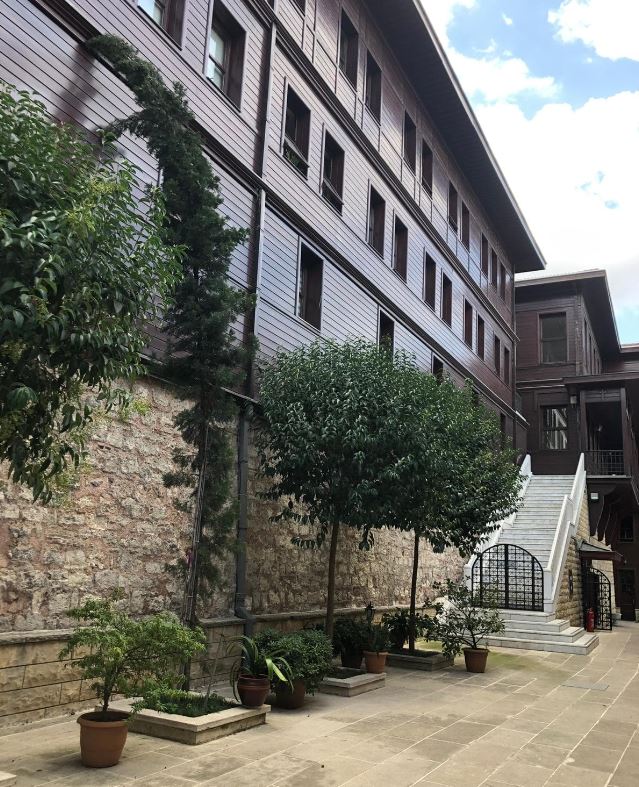
Before entering the facility, check out this door which was the original entrance. Patriarch Gregory V was hung in front of this door in 1821. And, the door was welded and never opened. This happened due to the Greek Revolution and the execution was ordered by Sultan Mahmud II.
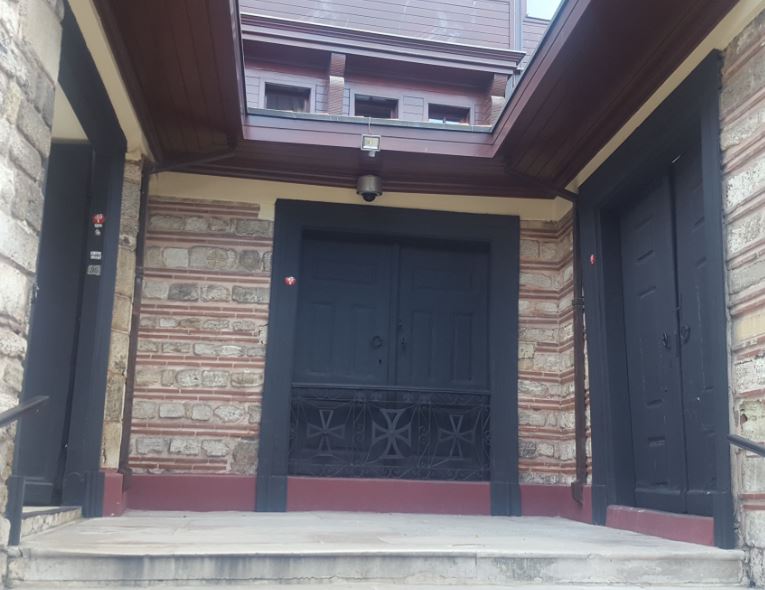
Right after, you can check the garden and the facility. The facility contains patriarchate offices which were a monastery before. Patriarchate offices are closed to visitors. We really wondered the Fatih Sultan Mehmed’s mosaic with Gennadios II containing firman or edict. Unfortunately, since this mosaic is in the patriarchate, you can only enter with special permission which is basically pretty tough. But, basically, the firman says that “You can still be a patriarch and have the same privileges as your predecessors” [8]. This smart move by the Sultan has different meanings. First, we can think that he was respectful to Orthodox rights. But, secondly, he never wanted that West (Catholic) and East (Orthodox) churches be together again 🙂 Check this link to find out more.
St. George Church
St. George is an important figure. The icons mostly represent himself riding a white horse and dealing with a dragon. He was an important general in the military but he was ordered by Roman King to kill people choosing Christianity. He declined this order and was agonized and killed right after.
At the entrance, you will see the candle stand and some icons about Mother Mary, Jesus Christ, Apostle St. Andrew and St. George.

Please note that there are balconies above which can be used during the rituals.
The church is not very big, but inside of the church is pretty good. The form is U-shape. There are two corridors divided by the ceremonial area and the place having chairs used by listeners. Moreover, the chandeliers are pretty good. Inside of the area in the middle, you will observe two cantor stalls.
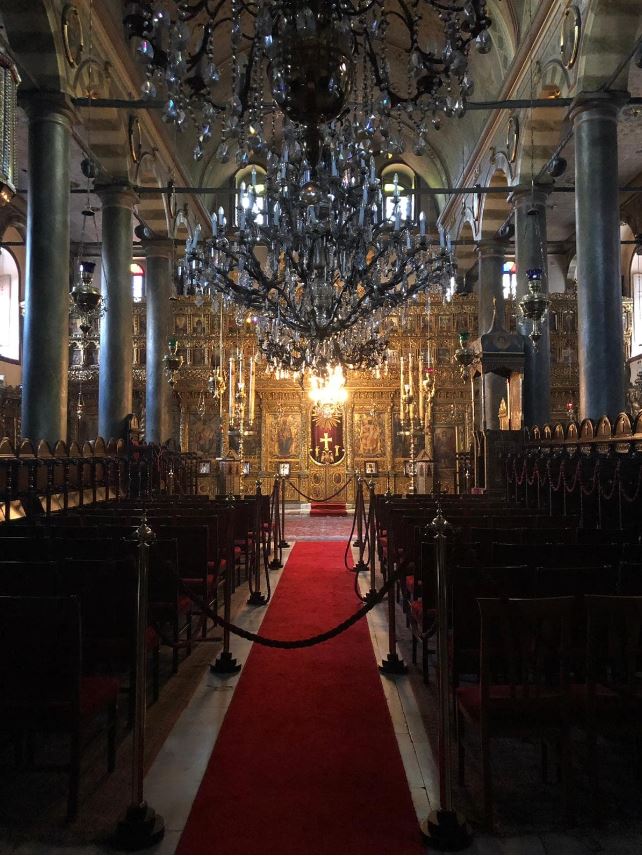
The glorious throne is pretty old and there are some resources referring that the throne was from the 5th century. The colors are very good and it is 4 meters tall. Moreover, the icon on the throne dates back to the 17th century.
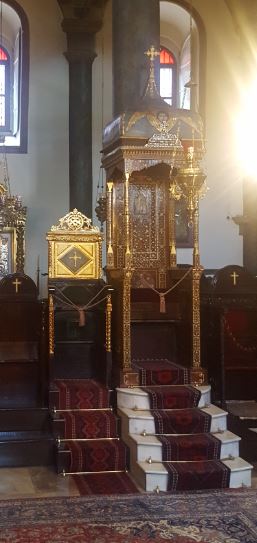
While checking the interior, you will also observe an old pulpit which is a raised platform in a church where the preachers can deliver a sermon.
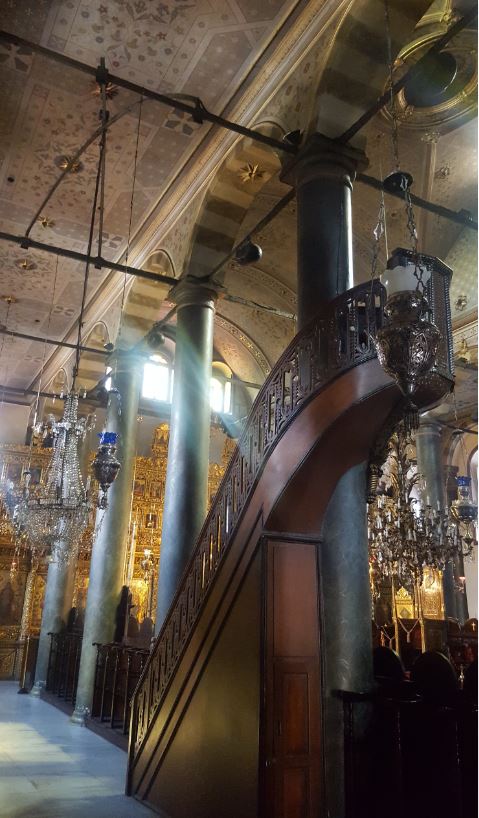
Iconostasis
You know the iconostasis is a specific wall dividing the Orthodox church where only priests or people having religious ranks can enter. It is said that there is an elevated marble throne for patriarch and 11 wooden thrones around it for Synod behind the iconostasis [9].
The iconostasis is brilliant and a mix of different styles. Unfortunately, despite big icons are visible, the small ones are barely visible. Basically, it is divided into three sections and levels having different concepts. [10]

Relics
At the corner, you will see one of the columns of Jesus Christ’s flagellation. That is one of the best relics in this church. Jesus was whipped by Roman soldiers before his crucifixion.

So, there are some relics belonging to three bishops. We believe that you know the big event, “return of the relics”. Basil the Great, Gregory the Theologian and John Chrysostom were three archbishops at the early period. The relics of St. Gregory and St. John were brought to Rome during the 4th Latin Crusade in 1204. So in 2004, they were given as gifts from Pope to the Fener patriarch and that was a very big event. This visit also intended to increased dialogue [11]. As a reminder, Pope and Bartholomew formally met in Jerusalem in 1964 after a lot of centuries and that event broke the ices between two churches. Additionally, Pope Benedict visited the church in 2006. [12]
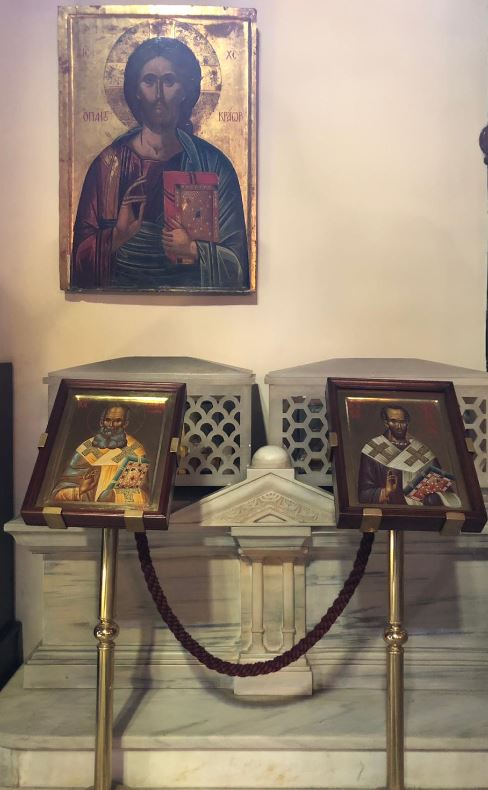
The relics of three remarkable women in history are also located in the church. The third set of relics is normally attributed to Solomone, however, it is believed that the relics belonging to St. Mary Salome. St. Euphemia had been grown in Chalcedon. She is one of the Great Martyrs. She refused to appear in a pagan festival due to believing in Christianity and was agonized and killed right after. St. Theophano was an empress and she was the wife of Leon VI. After being locked up in prison and getting her freedom back, she spent her life fully devoted to God and restoring monasteries and churches. There are different sources talking about St. Mary Salome with different information. Check out these links to find out more. [13, 14]
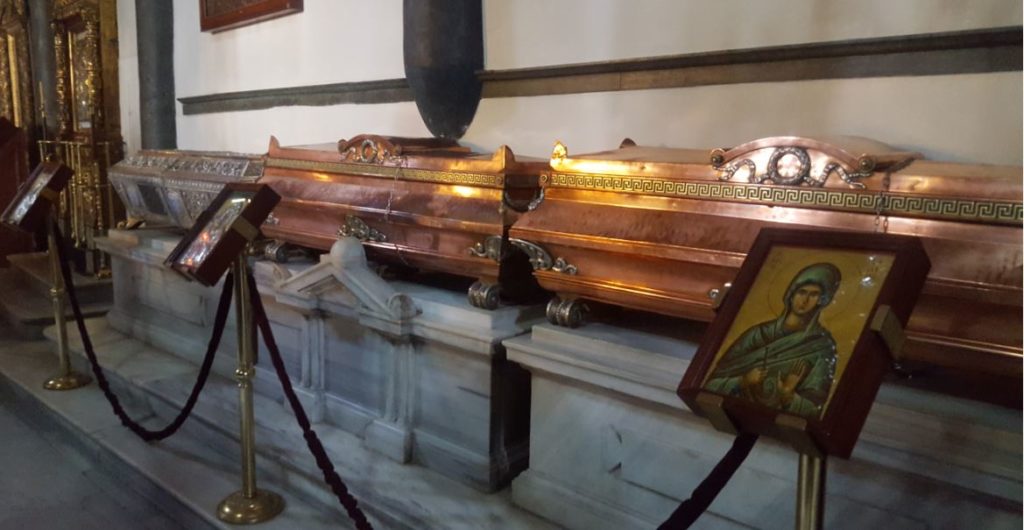
Icons
There are very good icons in this church. Let’s check a couple of important icons.
This 11th-century icon including Mother of Jesus and child Jesus is one of the historical icons. As we mentioned, the patriarchate changed its locations a couple of times. Between 1456 to 1587, Panaghia Pammakaristos which was converted to Fethiye mosque later served as a patriarchate. This icon was transferred to St. George church which was thought as the patron icon of Panaghia Pammakaristos. [15]
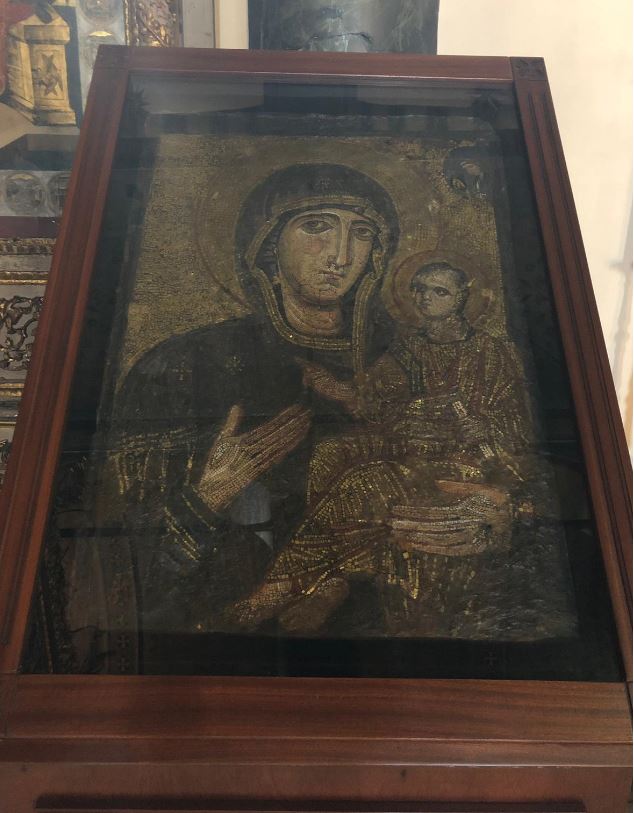
On the right side, you will observe St. John the Baptist or the Forerunner icon. It is also believed that this icon was also in the church of Panaghia Pammakaristos. [16]
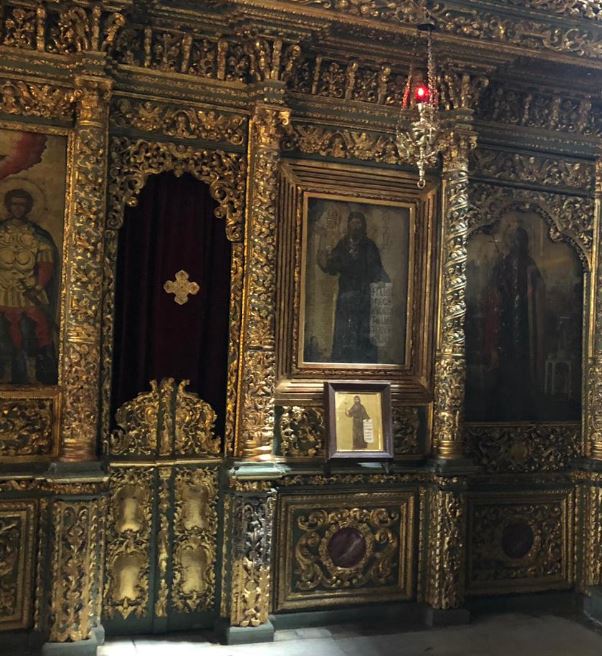
The other icon, Panaghia Faneromeni which was transferred from Kyzikos which is around Kapidag between Bandirma-Erdek in Turkey. Faneromeni means revealed, appeared or apparent. The icon contains a painting but having a gold-silver cover. [17]
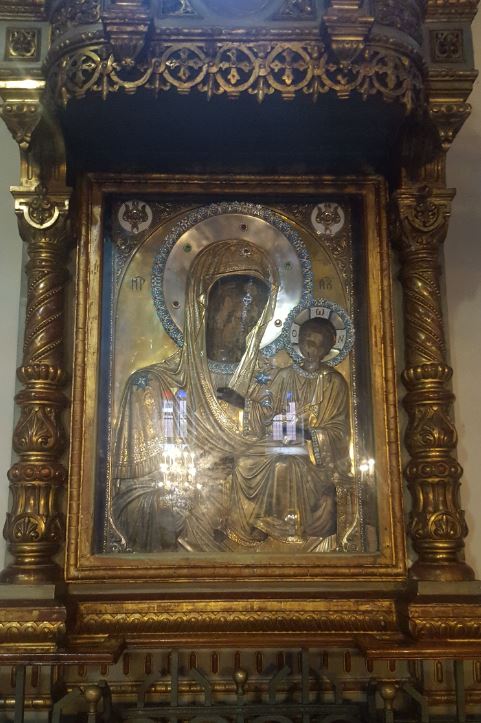
Where is the Greek Orthodox Patriarchate Istanbul?
This is very close to Fener pier. If you necessarily need its address, here it is. Btw, Fener means lighthouse 🙂
The official address: Yavuz Sultan Selim Mah., Dr. Sadik Ahmet Cad. No:44, 34083 Fatih/Istanbul
The Greek Orthodox Patriarchate Istanbul – How Much Time?
Unless you want to pray in the church, maximum 1 hour would be enough. Carefully check the iconostasis, icons, thrones, and tombs (or relics). Know the story, that will be very meaningful when you visit the church.
St. George Orthodox Church Istanbul Opening-Closing Days & Hours
The church is open every day. Sundays are mostly crowded due to activities, but you may have a chance to visit the interior and attend the event. However, taking photos, etc. can be tough on Sundays, so we recommend you to go there except Sunday unless you plan to pray. But, you may be able to see Bartholomew on Sundays if you are lucky 🙂
You can check the church in weekdays from 8 a.m. till 4:30 p.m and on weekends from 8 a.m. to 4 p.m. We like visiting the church in the mornings. You can also attend a ritual and watch it comfortably especially on weekdays. Check out the link before you go there to find out daily services. [18]
The Greek Orthodox Patriarchate Istanbul Ticket Price / Entrance Fee
You know this is still a church. The entrance is free, you can go and take a look regardless of your religion and feel it without paying anything. So, the museum pass question is not valid fort his church.
How to Reach Fener Greek Patriarchate?
There are many ways to reach St. George’s Church. However, we will recommend our favorite way first.
We believe that you are at one of the tourist attraction places. So, since we are in love with the Bosphorus, we mostly use Uskudar-Eyupsultan ferries to go to the church. There are many stops in this route and one of the stops is Karakoy. Don’t forget to get off at Fener Pier Stop. Right after, you will cross the road and walk around 3 minutes. Please note that this line is only once an hour.
From Uskudar
Definitely, use the city lines ferries to go to Fener pier.
From Karakoy/Eminonu
You can use Uskudar- Eyupsultan ferry from Karakoy. You know it is not hard to come here from Galata Tower, Blue Mosque, Hagia Sophia or Topkapi Palace. Otherwise, there are some bus options too. You can prefer to catch 99, 99A, 99Y, 399B, 399C, 36CE from Eminonu main bus station.
Btw, this is just 3-4 km, the taxi option would be cheap enough to go there.
From Kadikoy
You can both try to reach Uskudar by bus or Marmaray or Karakoy/Eminonu by ferry. Simply follow the steps above.
From Dolmabahce Palace
Try to reach Eminonu or Karakoy by bus or T1 from Kabatas. After that, you know it is easy 🙂
From Airports
You should come to Eminonu or Kadikoy from Istanbul new airport or Sabiha Gokcen airport. Havaist and Havatas are great options. Try to reach Karakoy from Kadikoy or Eminonu.
What to Remember During Your Visit?
It is good to be respectful to other people since this is a temple. You can take photos in the church.
This is a common mistake, but that red castle is not the St. George Church nor the Orthodox Patriarchate Istanbul. It is an Orthodox Greek high school and also historical. You can go and take a look, but the looking interior of this school can be tough 🙂

The timing is also important, try to be there during daylight. The region can be considered safe enough during the daytime, but be careful during nighttime when you walk around.
The season is also an important parameter, but this will not impact your visit. Check this out and find out the best time to visit Istanbul.
Conclusion
St. George church is fantastic. Moreover, Greek Orthodox Patriarchate Istanbul has a huge history. Combining two beauties into one location makes our visit better and easier. We recommend you to check every detail of this fantastic church.
Feeling the spirit is very important when you visit a city like Istanbul. Don’t miss the chance and visit the patriarchate regardless of your religion. One more note, definitely combine your visit with Bulgarian Iron church and don’t forget to enjoy the Fener/Balat region.
References
- https://www.patriarchate.org/biography
- https://www.britannica.com/topic/Ecumenical-Patriarchate-of-Constantinople
- https://classroom.synonym.com/why-did-pope-leo-iii-crown-charlemagne-the-first-holy-roman-emperor-12086572.html
- https://www.dummies.com/religion/christianity/catholicism/the-split-that-created-roman-catholics-and-eastern-orthodox-catholics/
- https://www.britannica.com/event/East-West-Schism-1054
- https://www.euronews.com/2016/11/25/catholic-and-orthodox-christian-churches-compared
- https://orthodoxwiki.org/List_of_autocephalous_and_autonomous_churches
- https://www.quora.com/Is-it-true-that-the-patriarch-of-Constantinople-declared-Mehmed-II-Caesar-when-the-city-was-invaded
- https://www.patriarchate.org/saintgeorge#
- https://www.archons.org/the-ecumenical-patriarchate/patriarchal-church-of-st.-george?content=The+Iconostasis
- https://www.youtube.com/watch?v=1Eztvp0CN4Q&t=144s
- https://www.youtube.com/watch?v=szTOlcz35eQ
- https://aleteia.org/2018/07/20/art-and-the-gospels-who-was-saint-salome/
- https://catholicexchange.com/st-mary-salome
- https://www.johnsanidopoulos.com/2015/09/synaxis-of-panagia-pammakaristos-of.html
- https://www.archons.org/the-ecumenical-patriarchate/patriarchal-church-of-st.-george?content=Three+Historical+Icons
- https://www.johnsanidopoulos.com/2010/08/miraculous-panagia-faneromeni-of-nea.html
- https://www.patriarchate.org/services